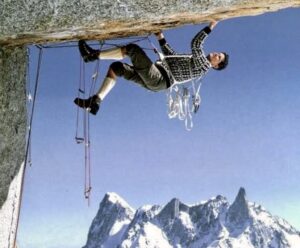The Wailing Wall (Scottish winter grade IX 9, 90m) sat in a remote gully on An Teallach without a repeat for more than a decade. The climbers who finally snagged the first repeat issued a report of the mixed climbing that helps explain why.
Climbers throughout the world revered Martin Moran for his bleeding-edge first ascents. He pioneered hard lines with vision and energy until his death in the Himalaya in 2019.
When he and Murdoch Jamieson arrived at the base of the Hayfork Wall on An Teallach (1,061m) in 2010, he saw its potential for exacting mixed routes. The high, steep wall already hosted a few test pieces, but Moran spotted an unclimbed line toward its upper-right section.
The line, climbed on-sight, became one of Scotland’s most challenging mixed routes and an instant classic. The Wailing Wall checks in just below the top of the Scottish winter climbing grade scale.
Twelve years later, Guy Robertson and Adam Russell secured the route’s first repeat.
No suitable prep
Predictably, the repeat did not prove easy. The two hadn’t climbed hard on actual rock and ice in quite some time because of COVID-19. And Robertson knew that Moran’s legendary reputation virtually guaranteed that the route would be severe.
The climbing looked like it would push him and Russell to the breaking point.
“At grade IX 9, [Moran] had suggested that this was his hardest (as well as one of his best) routes to date. I was immediately intrigued –- I knew from bitter experience that this man didn’t hand out big numbers easily, and a route at such a high standard effectively finding the easiest way up a large area of cliff is a rare thing indeed,” Robertson told UK Climbing.
Like the British trad scale, the Scottish winter climbing scale considers objective danger and technical difficulty. The Roman numeral indicates how dangerous the lead is; the number relates to the difficulty of the movement. The scale’s top end is XI 11.
View this post on Instagram
The Wailing Wall first repeat details
Climbers can only attempt ascents at the Hayfork Wall during winter. The sandstone is notably loose. Without snow and ice to bind it together, climbers consider it impossible. On the other hand, the wall is steep and sheer, which means that ax and crampon placements are minimal.
The Wailing Wall’s crux arrives abruptly. Easy but unprotectable climbing on grass leads to an eight-metre shimmy across a narrow ledge. Then, the wall sweeps outward into the crux overhang.
Evaluating Robertson’s description of the climbing, it’s worth remembering that he draws from the same humble tradition Moran does. For generations, refusing to overstate difficulty or danger has been a hallmark of hard people.
“A crack in the smooth wall some 10 metres above sports some vague sloping snow patches and discernible turf, but the wall barring access overhangs considerably,” Robertson stated. “The gear isn’t perfect, and as with all northwest sandstone routes on big ‘winter only’ cliffs, the threat of detachable rock always lurks menacingly. An assured and powerful approach is required. There are no footholds worth mentioning, only shallow vertical mossy seams. A series of deep and committing lock-offs on poor torques is effected to eventually reach the crack above. The considerable horizontal separation distance from the belay at this point undoubtedly heightens the anxiety.”
Robertson navigated the crux without notable incident. The rest of the route, though not as prohibitive, still facilitated good climbing as well as exposure that he called “stupendous.”

The Wailing Wall, IX 9. Photo: Hamish Frost Photography
The men submitted with The Wailing Wall’s coveted second ascent as the afternoon light faded.
Training for hard, dangerous mixed climbing…in the gym?
Counterintuitively, Robertson trained for The Wailing Wall’s grim, technical mixed climbing by pulling on training boards in an indoor facility. The situation resulted from quarantine, but it gave him and Russell minimal recent experience on hard rock and ice.
To psych himself up for the route, he said he took a moment at the base to reflect on Moran’s bold example.
“I had a few quiet words to myself. Something along the lines that it was mostly a slab, not a patch on those forearm-pumping repeater circuits on the 40-degree board. If Martin was psyched enough to forge through the initial steepness and get involved in the main wall, then so should I be.”
Fittingly, he also added a dash of self-deprecation before taking his first swing.
“The fact that he was a much more accomplished, experienced, cunning, and consummate mountaineer than I’ll ever be was a minor detail I chose to ignore!”






